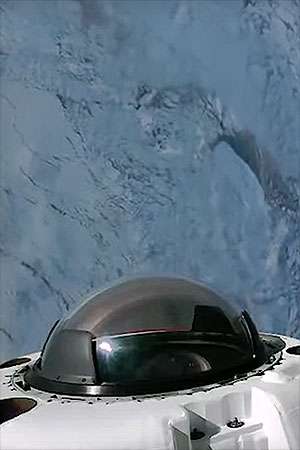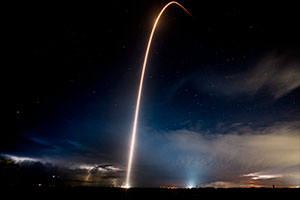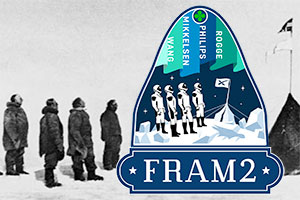March 31, 2025 — After more than 60 years and almost 360 missions, a crew of private astronauts has done something never before done in human spaceflight — they headed due south off the launch pad.
The Fram2 crew — named after after the sea ship that first reached Earth's polar regions in the 1800s — are now the first humans to enter a 90-degree circularized orbit such that they will fly over both the North and South poles. While satellites have and continue to follow such a path, Chun Wang, Jannicke Mikkelsen, Rabea Rogge and Eric Philips will be the first humans to see firsthand the top and bottom our planet from space.
"I didn't want to repeat the same mission profile that has been repeated again and again," said Wang, whose idea it was to fly a polar mission and is underwriting the flight, in a pre-launch audio stream on the X social network. "There's a big bunch of area that is the polar area that is largely ignored."
The four Fram2 astronauts lifted off aboard SpaceX's Crew Dragon "Resilience" on Monday (March 31). The capsule, which previously flew NASA's Crew-1 to the International Space Station and SpaceX's two earlier commercial, free-flying missions, Inspiration4 and Polaris Dawn, launched again atop a Falcon 9 rocket from Pad 39A at NASA's Kennedy Space Center in Florida at 9:46 p.m. EST (0146 GMT on April 1).
The ascent proceeded much like all of SpaceX's Dragon flights, but instead of flying up the U.S. eastern seaboard before heading northeast over the Atlantic Ocean to reach a 51.6-degree inclination, the rocket headed straight south, flying directly above Miami before passing over Cuba, Panama and then just west of Peru and Ecuador.
Once spent, the Falcon 9's first stage set down on the droneship "A Shortfall of Gravitas" in international waters just outside of the Bahamian territory. The stage previously launched NASA's Crew-9 astronauts and Firefly Aerospace's Blue Ghost-1 moon lander among its five prior missions.
Fram2 is planned as a nearly-four-day-long flight, during which Resilience will fly the crew from pole to pole in record breaking time.
"We broke the world record for the fastest polar circle navigation over the North Pole and South Pole," said Mikkelsen, who as part of the One More Orbit flight crew helped set a Guinness World Record for the fastest circumnavigation of Earth via both poles by an aircraft in 2019. "We're actually getting quite close to that record that we set for One More Orbit, which was at 46 hours, but now we are almost going from the North Pole to the South Pole in 46 minutes and not hours."
Aurora, X-rays and mushrooms
More than just a sightseeing trip or a pursuit of making history, Fram2 is intended to "honor the adventuring spirit of early polar explorers" while advancing research and technology for future human missions into space.
Fram2 mission commander Wang, who was born in China, now lives in Malta and made his fortune in cryptocurrency, chose for his crew: Mikkelsen, the first professional cinematographer to fly into space; Rogge, Germany's first woman in space and a robotics expert focused on Arctic research; and Philips, an Australian professional adventurer who has completed multiple ski expeditions to both poles.
During the flight, the four Fram2 crew members will conduct simultaneous aurora observations with citizen scientists.
"We have reached out to 2.2 million auroral citizen scientists, but anyone can join if there is aurora where you live. You can register on the SolarMax mission website and then take a photo of the aurora at the same time as we fly over the aurora," said Mikkelsen. "We will get this incredible databank from our mission of the aurora from Earth and from space at the same time, so we can understand what the phenomena can bring to humankind and specifically to satellite technology."
The crew will also carry out 22 research projects, including taking the first X-rays of humans in space; using a smart ring (Oura) to track their sleep patterns; and grow the first mushrooms in space.
"They will be partially grown once we fly up there and we will just have a look at how they're growing," said Phillips, specifying they are oyster mushrooms. "We won't have the opportunity to to harvest them as that's about a 10-day duration, but we will monitor and see how they grow and return those mushrooms down for the researchers to check out."
Other areas of study will include blood flow restriction; brain anatomy by using a mobile MRI device; glucose regulation in space; the effect of microgravity on female reproductive hormones; anemia and blood health; the severity and time course of motion sickness; and bone health using advanced imaging. After they splash down, the Fram2 crew will also take part in an egress study to characterize their ability to perform unassisted functional tasks soon after landing from space.
Polar predecessors
Wang, Mikkelsen, Rogge and Phillips have with them in space a piece of the original Fram ship deck, on loan from the Fram Museum in Norway. The block of wood was signed by Oscar Wisting, who joined Roald Amundsen to the South Pole in 1911 and to the North Pole on board the airship Norge in 1926.
Prior to the Fram2 mission, the highest inclination that was achieved on a human spaceflight was 65 degrees, as reached by Valentina Tereshkova, the world's first woman to fly into space. She and her other early Soviet cosmonauts followed similar trajectories.
"Interestingly, the closest anyone's ever come was Yuri Gagarin and some of those really early Soviet cosmonauts during the Vostok program in the early 60s, and they flew to about 65 degrees. So that's quite a bit different than what the Fam2 crew is doing," said Jon Edwards, vice president of Falcon launch vehicles at SpaceX.
The 24 NASA astronauts who flew on Apollo missions to the moon are the only other humans to see the poles from space and then it was from a much farther distance away. The highest inclination flown on a U.S. human spaceflight was by the space shuttle Atlantis, which achieved 62 degrees to deploy a classified payload for the U.S. Department of Defense in March 1990.
The U.S. Air Force had plans to launch astronauts into polar orbit on dedicated space shuttle missions as early as July 1986. Those flights (including STS-62-A with crew members Robert Crippen, Guy Gardner, Mike Mullane, Jerry Ross, Dale Gardner, Edward Aldridge and Brett Patterson) were canceled, along with the use of Space Launch Complex-6 (SLC-6) at Vandenberg Space Force Station (then Air Force Station) in southern California, in the wake of the Challenger disaster in January of that year. |
|

SpaceX's Crew Dragon "Resilience" is seen over a polar region of Earth at the start of the Fram2 mission, March 31, 2025. (SpaceX)

Timelapse streak of the SpaceX Falcon 9 rocket carrying the Crew Dragon "Resilience" and Fram2 astronauts into polar orbit from the Kennedy Space Center in Florida on March 31, 2025. (SpaceX)

The Fram2 crew is seen on SpaceX's Crew Dragon "Resilience"; from left to right: Eric Phillips, mission specialist; Rabea Rogge, pilot; Jannicke Mikkelsen; vehicle commander; and Chun Wang, mission commander. (SpaceX)

The Fram2 mission has on board a piece of the original Fram ship deck signed by Oscar Wisting, who joined Roald Amundsen to the South Pole in 1911 and to the North Pole on the airship Norge in 1926, on loan from the Fram Museum in Norway. (Fram Museum)

The Fram2 mission patch is based on a photo of Roald Amundsen and his expedition team at the South Pole in 1911. (Fram2/SpaceX) |
